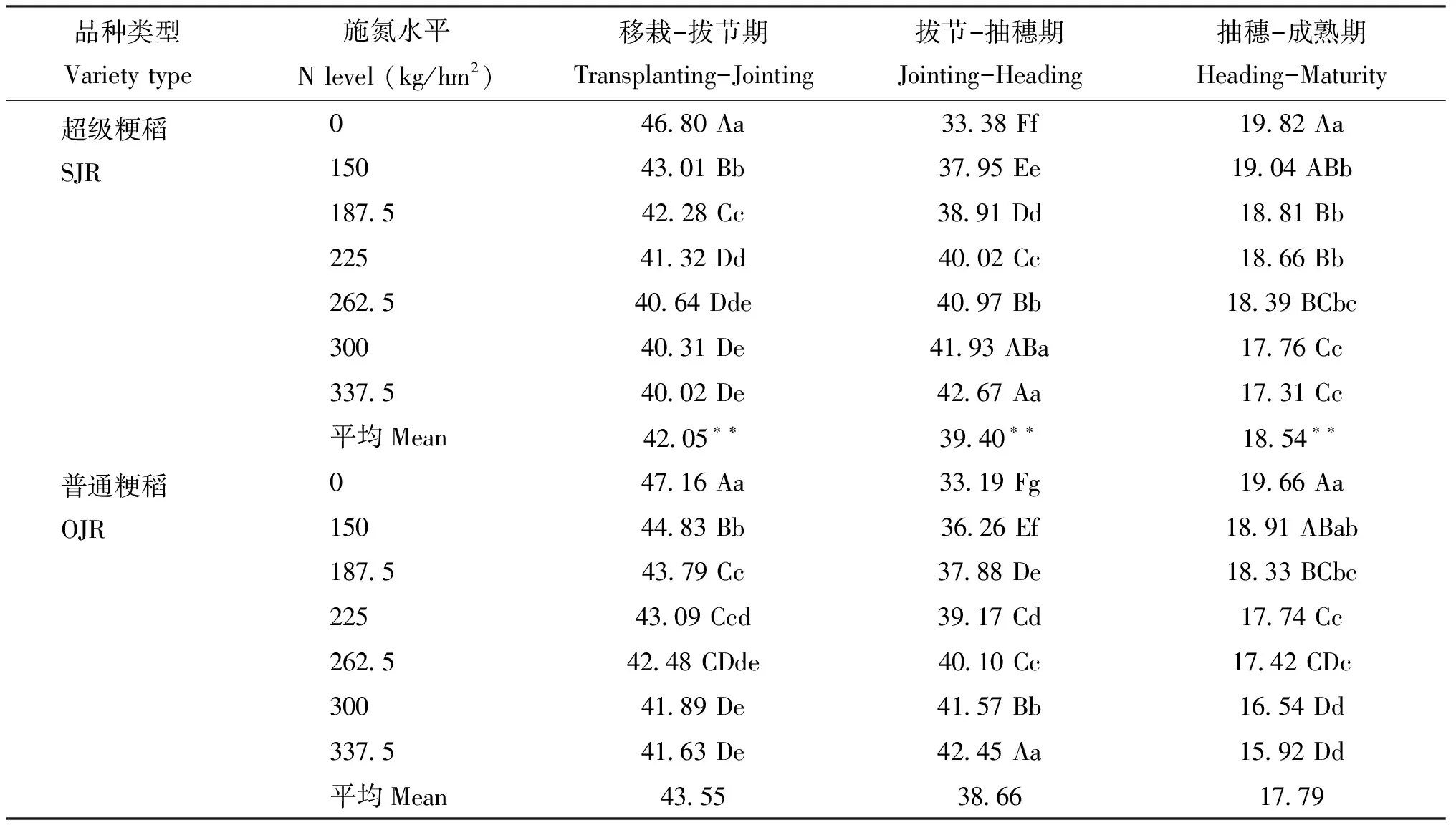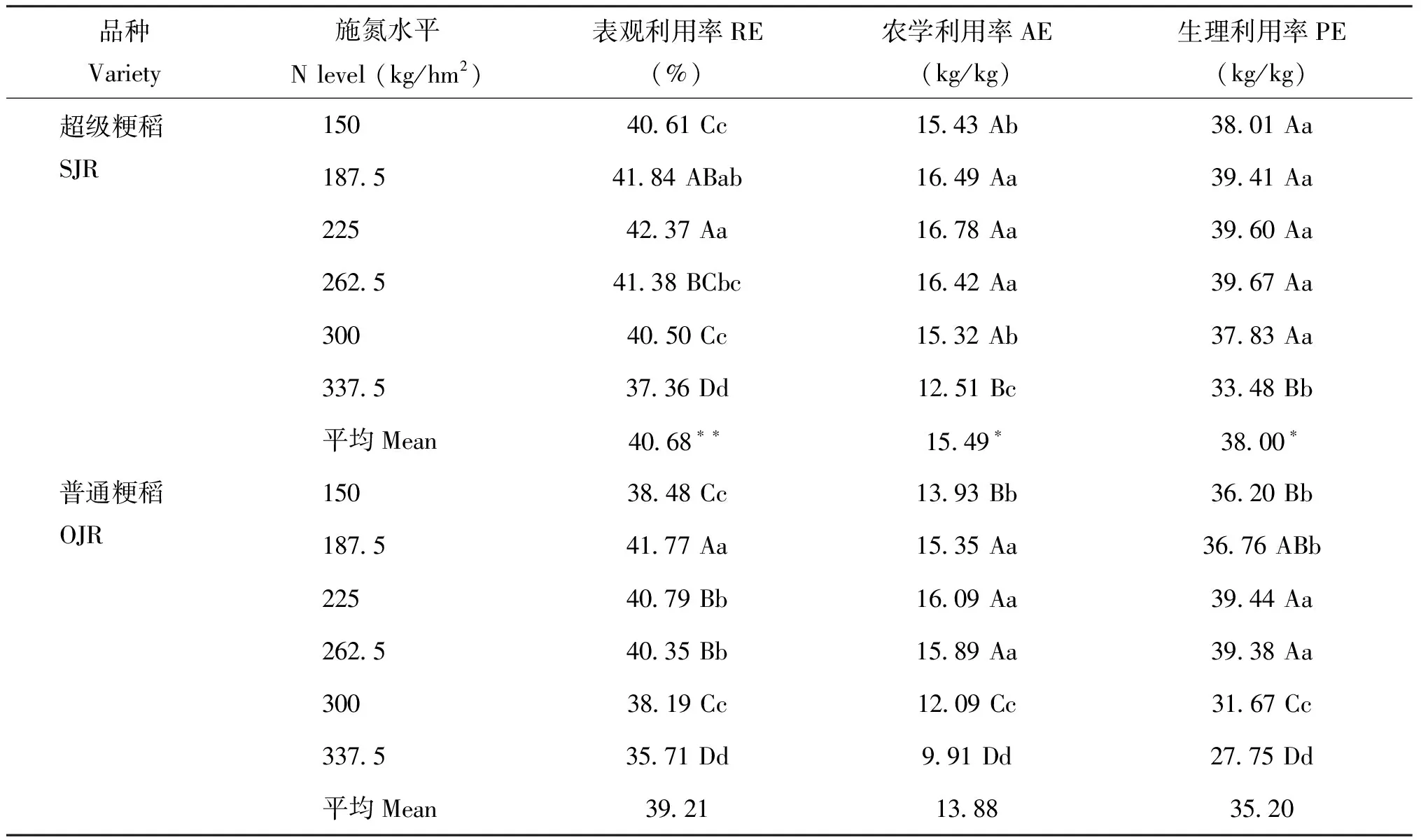长江中下游稻区粳型超级稻高产形成及氮素利用的研究
2014-04-01葛梦婕王亚江颜希亭张洪程魏海燕戴其根霍中洋朱聪聪
葛梦婕, 王亚江, 颜希亭, 张洪程, 魏海燕, 戴其根, 霍中洋, 许 轲, 江 峰, 朱聪聪
(扬州大学农业部长江流域稻作技术创新中心,江苏省作物遗传生理国家重点实验室,江苏扬州 225009)
中国是世界上水稻生产和消费的主要国家之一,高产一直是我国水稻工作的永恒主题[1-2]。超级稻品种是通过理想株型塑造与杂种优势利用相结合选育的单产大幅度提高、 品质优良的新型水稻品种组合,可能成为我国继矮化育种和杂种优势利用两次突破后第三次育种革命[3]。我国水稻种植一直维持“北粳南籼”的格局,近年来由于粳稻产量、 品质、 效益方面的优势明显,粳稻种植面积逐渐扩大,特别是自“七五”、 “八五”以来,我国的“籼改粳”取得长足进步,生产上也相继推出一些高产优质的常规粳型超级稻品种,这些品种主要集中分布在长江中下游稻区,至2013年我国审定通过的南方粳型常规超级稻品种达11个之多。

1 材料与方法
1.1 供试品种

1.2 试验设计
试验采用裂区设计,以施氮(N)水平为主区,设N 0、 150、 187.5、 225、 262.5、 300、 337.5 kg/hm27个水平。以品种为裂区,裂区面积为6 m2,重复3次。主区间做埂隔离,并用塑料薄膜覆盖埂体,保证各主区单独排灌。试验采用机插软盘育秧,于5月23日播种,6月11日移栽,栽插规格为11.7 cm×30.0 cm,每穴3苗。氮肥基蘖肥 ∶穗肥=6 ∶4,穗肥分别于倒四、 倒二叶各施50%;P、 K肥施用与高产田相同,施P2O5、 K2O 各150 kg/hm2,全部用作基肥。氮肥用尿素(含氮46.4%),磷肥用过磷酸钙(含P2O512%),钾肥用氯化钾(含K2O 60%)。其他管理措施按照常规高产栽培要求实施。
1.3 测定内容与方法
1.3.1 茎蘖动态 在各处理小区定点20穴作为观察点,于有效分蘖临界期、 拔节期、 抽穗期、 成熟期观察茎蘖消长动态。
1.3.2 叶面积和干物质测定 于拔节、 抽穗和成熟期取有代表性植株2穴,用Li-3000A型自动叶面积仪测量植株叶面积。105℃杀青,75℃烘干至恒重后称其重量。
1.3.3 植株全氮测定 植物样品粉碎后,用半微量凯氏定氮法测定全氮含量。
1.3.4 产量的测定 收获前每小区收割50穴,脱粒,晒干,测定实际产量;每小区取10株成熟稻穗,自然风干用于测定产量构成因素。
1.4 数据计算与分析方法
光合势=1/2(L1+L2)×(t1-t2)
式中: L1、 L2为前后两次测定的叶面积(m2/hm2); t1、 t2为前后两次测定时间(d)。
氮肥表观利用率(%)=(施氮区水稻吸氮量-氮空白区水稻吸氮量)/作物施氮量×100
农学利用率(kg/kg)=(施氮区水稻产量-氮空白区水稻产量)/施氮量
生理利用率(kg/kg)=(施氮区水稻产量-氮空白区水稻产量)/(施氮区水稻吸氮量-氮空白区水稻吸氮量)
使用Microsoft Excel 2003处理数据,唐启义的DPS软件进行统计分析。
2 结果与分析
2.1 不同氮肥水平下不同类型水稻品种产量及其构成因素的差异
2.1.1 产量总体差异 对两年内,两类品种不同氮肥水平下的籽粒产量和氮素利用率进行方差分析可知(表1),品种类型间、 氮肥水平间、 氮肥和品种类型互作都达到了显著或极显著水平;年度、 年度与氮肥、 年度与品种类型以及三因素互作间差异均未达到显著水平,说明本试验设计合理,具有一定的准确性和代表性,能真实反映两类水稻品种在各氮肥水平下的差异。

表1 不同氮肥水平不同品种类型水稻籽粒产量和氮素利用的方差分析Table 1 Analysis of variance for grain yield and N recovery efficiency of different varieties under different nitrogen levels

由于2011、 2012年两年不同处理间产量变化趋势基本一致,本文仅以2012年的数据进行分析说明。

图1 不同氮肥水平下不同类型品种水稻的籽粒产量Fig.1 Grain yield of different variety type rice under different N level[注(Note): SJR—Super japonica rice; OJR— Ordinary japonica rice.]
2.1.2 产量构成因素的差异 由表2可见,随施氮量的增加,各品种穗粒数逐渐增加,结实率和千粒重逐渐下降,总颖花量先增后降。超级粳稻有效穗数略低于普通粳稻,但差异不显著,穗粒数、 总颖花量优势明显,平均每穗150粒,最高达到164粒,平均比普通粳稻高13.66%。与普通粳稻相比,超级粳稻千粒重略高,但结实率偏低,平均只有90.10%,尤其高氮条件下,结实率更低,最低只有88.37%。因此,生产中超级粳稻高产实现的途径应在稳定适宜穗数基础上培育大穗,提高群体总颖花量,减少颖花退化,保持相对稳定的结实率和千粒重。
2.2 不同氮肥水平下不同类型品种水稻的群体特征



表2 不同氮肥水平下不同类型品种水稻产量及其构成因素Table 2 Yield and its components in different variety type rice under different N levels
注(Note): SJR—Superjaponicarice; OJR— Ordinaryjaponicarice. 不同大小写字母表示氮肥水平间差异达1%和5%显著水平 The different capital and small letters represent significant difference between nitrogen levels at the 1% and 5% levels, respectively; ** 表示不同品种类型平均值之间差异达1%显著水平 Indicate the average value between different varieties were significantly different at the 1% level.

表3 不同氮肥水平下不同类型水稻品种茎蘖数及成穗率Table 3 Number of stems and tillers and percentage of productive tillers in different variety type rice under different N levels
注(Note): SJR—Superjaponicarice; OJR— Ordinaryjaponicarice. 不同大小写字母表示氮肥水平间差异达1%和5%显著水平 The different capital and small letters represent significant difference between nitrogen levels at the 1% and 5% levels, respectively; ** 表示不同品种类型平均值之间差异达1%显著水平 Indicate the average value between different varieties were significantly different at the 1% level.


各阶段的干物质积累比例变化趋势(表7),随施氮量的增加,拔节前干物质积累比例表现为先降后增的趋势,拔节后与干物质积累量变化趋势一致。施氮量过高时,干物质积累比例在生育前期较大,容易造成群体荫庇,从而生育后期干物质积累比例相对减少。与普通粳稻相比,超级粳稻在拔节前干物质积累比例较低,拔节后尤其是抽穗至成熟阶段干物质积累比例较高,两者差异极显著。
注(Note): SJR—Superjaponicarice; OJR— Ordinaryjaponicarice. 不同大小写字母表示氮肥水平间差异达1%和5%显著水平 The different capital and small letters represent significant difference between nitrogen levels at the 1% and 5% levels, respectively; ** 表示不同品种类型平均值之间差异达1%显著水平 Indicate the average value between different varieties were significantly different at the 1% level.
注(Note): SJR—Superjaponicarice; OJR— Ordinaryjaponicarice. 不同大小写字母表示氮肥水平间差异达1%和5%显著水平 The different capital and small letters represent significant difference between nitrogen levels at the 1% and 5% levels, respectively; ** 表示不同品种类型平均值之间差异达1%显著水平 Indicate the average value between different varieties were significantly different at the 1% level.

表6 不同氮肥水平下不同类型品种阶段干物质积累量(kg/hm2)Table 6 Dry matter accumulation at each growth stage in different variety type rice under different N levels
注(Note): SJR—Superjaponicarice; OJR— Ordinaryjaponicarice. 不同大小写字母表示氮肥水平间差异达1%和5%显著水平 The different capital and small letters represent significant difference between nitrogen levels at the 1% and 5% levels, respectively; ** 表示不同品种类型平均值之间差异达1%显著水平 Indicate the average value between different varieties were significantly different at the 1% level.

表7 不同氮肥水平下不同类型品种阶段干物质积累比例(%)Table 7 Dry matter accumulation ratio at each growth stage in different variety type rice under different N levels
注(Note): SJR—Superjaponicarice; OJR— Ordinaryjaponicarice. 不同大小写字母表示氮肥水平间差异达1%和5%显著水平 The different capital and small letters represent significant difference between nitrogen levels at the 1% and 5% levels, respectively; ** 表示不同品种类型平均值之间差异达1%显著水平 Indicate the average value between different varieties were significantly different at the 1% level.
2.3 不同类型品种水稻氮素积累特性

对各生育阶段氮素积累比例进行分析(表9),随施氮量的增加,各水稻品种移栽-拔节期氮素积累比例表现为减小的趋势,拔节-抽穗期表现为增加的趋势,而抽穗-成熟期表现为先增后降的趋势。不同品种类型间相比较,拔节前,普通粳稻氮素积累比例较超级粳稻高,而拔节后尤其是抽穗-成熟期超级粳稻的氮素积累比例更高。


表8 不同氮肥水平下不同类型品种水稻阶段氮素积累量(kg/hm2)Table 8 N accumulation at each growth stage in different variety type rice under different N levels
注(Note): SJR—Superjaponicarice; OJR— Ordinaryjaponicarice. 不同大小写字母表示氮肥水平间差异达1%和5%显著水平 The different capital and small letters represent significant difference between nitrogen levels at the 1% and 5% levels, respectively; ** 表示不同品种类型平均值之间差异达1%显著水平 Indicate the average value between different varieties were significantly different at the 1% level.

表9 不同氮肥水平下不同品种类型水稻阶段氮素积累比例(%)Table 9 N accumulation ratio at each growth stage in different variety type rice under different N levels
注(Note): SJR—Superjaponicarice; OJR— Ordinaryjaponicarice. 不同大小写字母表示氮肥水平间差异达1%和5%显著水平 The different capital and small letters represent significant difference between nitrogen levels at the 1% and 5% levels, respectively; ** 表示不同品种类型平均值之间差异达1%显著水平 Indicate the average value between different varieties were significantly different at the 1% level.

表10 不同氮肥水平下不同品种类型水稻氮素利用率Table 10 N utilization efficiencies in different variety type rice under different N levels
注(Note): RE— Recovery efficiency; AE—Agronomic efficiency; PE—Physiological efficiency.不同大小写字母表示氮肥水平间差异达1%和5%显著水平 The different capital and small letters represent significant difference between nitrogen level was significant at the 1% and 5% levels, respectively; *、 **表示不同品种类型平均值之间差异达5%和1%显著水平 Indicate the average value between different varieties were significantly different at 5% and 1% levels, respectively.
3 讨论
3.1 粳型超级稻高产形成及氮素利用的分析

3.2 粳型超级稻高产栽培途径的探讨
当前超级粳稻生产中依旧沿用人们所习惯的普通粳稻栽培管理模式,限制了超级粳稻品种高产和超高产潜力的发挥[17],只有良种良法配套才能实现水稻增产。超级粳稻主要依靠健壮的个体来提高群体质量,大田机械化生产中通过培育壮秧、 插足基本苗数来建立合理的群体高光效结构,保证有效穗数提高成穗率。超级稻的适宜施肥量因品种、 地力、 栽培管理方式等不同而存在差异[7,9,10]。本研究中,超级粳稻在施氮量300 kg/hm2水平下产量最高,产量能够达到10.5 t/hm2以上,表明超级粳稻适宜用作机插。相对于普通粳稻,超级粳稻获得高产所需的氮肥量大,而且在高氮条件下有高的生物量和氮素积累,因此在生产中须保证氮肥的足量投入。除此之外,超级粳稻由于穗型较普通粳稻大,应针对其干物质和氮素积累特点,严格控制基肥和分蘖肥施用时间和用量,保证超级粳稻生育前期氮素适度积累[18],控制群体稳步增长;将穗肥施用时期提前,施肥比例增加,能协调拔节至抽穗阶段营养生长和生殖生长,培育粗壮的茎秆和挺拔的株型,提高光合物质生产,从而保证在抽穗后能有更多的同化物输出,而且在生育后期能维持叶片不早衰,进一步提高光合产物积累促进大穗形成;同时通过施用钾肥增加茎秆强度[19],为大穗提供强有力的支撑,提高抗倒能力。超级粳稻地上部分生长优势与根系发育密切相关[20,21],利用轻搁田与结实期干湿交替灌溉技术能有效提高根系活力[22],增强生育后期根系吸氮能力,提高水稻氮素利用效率。保证氮肥投入是增产的有效措施,氮肥过量施用会降低肥料利用率,目前生产上选用的缓释氮肥以及采用实地氮肥管理技术(SSNM)、 水稻精确施肥技术[23,24]并结合水分管理,均能在提高超级粳稻产量的同时提高氮素利用效率。
4 结论
与常规普通粳稻相比,超级粳稻产量构成表现为穗数稳、 粒数多、 总颖花量高;群体特征表现为茎蘖消长平稳,叶面积指数和光合势较高,拔节后干物质积累量和积累比例较高;氮素吸收和利用表现为拔节后氮素积累量和积累比例高,氮素利用效率较高,且在高氮条件下比普通粳稻更能发挥优势。
参考文献:
[1] 王志敏, 王树安. 发展超高产技术, 确保中国未来16亿人口的粮食安全[J]. 中国农业科技导报, 2000, 2(7): 8-11.
Wang Z M, Wang S A. Develop super high yield techniques of grain crops for feeding 1.6 billion people in future[J]. Rev. China Agric. Sci. Technol., 2000, 2(7): 8-11.
[2] 凌启鸿, 张洪程, 丁艳锋, 等. 水稻高产技术的新发展—精确定量栽培[J]. 中国稻米, 2005, 1: 3-7.
Ling Q H, Zhang H C, Ding Y Fetal. The new development of the technique for high yield rice_precise and quantitative cultivation[J]. China Rice, 2005, 1: 3-7.
[3] 徐庆国. 超级稻的研究现状与发展对策探讨[J].作物研究, 2006(1): 13-16, 25.
Xu Q G. Discussion on the research and development countermeasures of super rice[J]. Crop Res., 2006(1): 13-16, 25.
[4] 凌启鸿. 水稻群体质量理论与实践[M]. 北京: 中国农业出版社, 1995: 34-44.
Ling Q H. Theory and practice of rice population quality[M]. Beijing: China Agriculture Press, 1995: 34-44.
[5] 史鸿儒, 张文忠, 解文孝, 等. 不同氮肥施用模式下北方粳型超级稻物质生产特性分析[J].作物学报, 2008, 34(11): 1985-1993.
Shi H R, Zhang W Z, Xie W Xetal. Analysis of matter production characteristics under different nitrogen application patterns ofjaponicasuper rice in North China[J]. Acta Agron. Sin, 2008, 34(11): 1985-1993.
[6] 陈爱忠, 潘晓华, 吴建富, 等. 施氮量对双季超级稻产量、 干物质生产及氮素吸收利用的影响[J]. 杂交水稻, 2011, 26(2): 58-63.
Chen A Z, Pan X H, Wu J Fetal. Effects of nitrogen application amount on yield, dry matter production and N-uptake and utilization of double-cropping super rice[J]. Hybrid Rice, 2011, 26(2): 58-63.
[7] 唐启源, 邹应斌, 米湘成, 等. 不同施氮条件下超级杂交稻的产量形成特点与氮肥利用[J]. 杂交水稻, 2003, 18(l): 44-48.
Tang Q Y, Zou Y B, Mi X Cetal. Grain yield construction and N fertilizer efficiency of super hybrid rice under different N applications[J]. Hybrid Rice, 2003, 18(l): 44-48.
[8] 吴桂成, 张洪程, 戴其根, 等. 南方粳型超级稻物质生产积累及超高产特征的研究[J].作物学报, 2010, 36 (11): 1921-1930.
Wu G C, Zhang H C, Dai Q Getal. Characteristics of dry matter production and accumulation and super-high yield ofjaponicasuper rice in South China[J]. Acta Agron. Sin, 2010, 36 (11): 1921-1930.
[9] 李国业, 张洪程, 李敏, 等. 超级杂交早稻氮肥群体最高生产力及其增长特征[J]. 植物营养与肥料学报, 2012, 18(4): 786-795.
Li G Y, Zhang H C, Li Metal. Population productivity and properties of early super hybrid cultivars under nitrogen fertilization[J]. Plant Nutr. Fert. Sci. 2012, 18(4): 786-795.
[10] 张军, 张洪程, 戴其根, 等. 淮北不同地力水平麦茬田上施氮量对超级稻产量形成的影响[J]. 生态学杂志, 2011, 30(10): 2297-2305.
Zhang J, Zhang H C, Dai Q Getal. Effects of nitrogen application rate on the yield and yield formation of super rice in rice-wheat double cropping system under different levels of soil fertility in Huaibei region[J]. Chin. J. Ecol., 2011, 30(10): 2297-2305.
[11] 吴桂成, 张洪程, 钱银飞, 等. 粳型超级稻产量构成因素协同规律及超高产特征的研究[J]. 中国农业科学, 2010, 43(2): 266- 276.
Wu G C, Zhang H C, Qian Y Fetal. Rule of grain yield components from high yield to super high yield and the characters of super-high yieldingjaponicasuper rice[J]. Sci. Agric. Sin., 2010, 43(2): 266-276.
[12] Kato T, Shinmura D, Taniguchi A. Activities of enzymes for sucrose-starch conversion in developing endosperm of rice and their association with grain filling in extra-heavy panicle types[J]. Plant Prod Sci, 2007, 10: 442-450.
[13] Yang J, Zhang J. Grain filling problem in “super” rice[J]. J Exp Bot, 2010, 61: 1-5
[14] 刘建丰, 袁隆平, 邓启云, 等. 超高产杂交稻的光合特性研究[J]. 中国农业科学, 2005, 38: 258-264.
Liu J F, Yuan L P, Deng Q Yetal. A study on characteristics of photosynthesis in super high-yielding hybrid rice[J]. Sci Agric Sin., 2005, 38: 258-264.
[15] 翟虎渠, 曹树青, 万建民, 等. 超高产杂交稻灌浆期光合功能与产量的关系[J].中国科学(C辑), 2002, 32(3): 211-217.
Zhai H Q, Cao S Q, Wan J Metal. Relation between photosynthetic functions at grain-filling stage and yield of super high-yielding hybrid rice[J]. Sci. China (Ser. C), 2002, 32(3): 211-217.
[16] Novoa R, Loomis R S. Nitrogen and plant production[J]. Plant Soil, 1981, 58: 177-204.
[17] Peng S B, Tang Q Y, Zou Y B. Current status and challenges of rice production in China[J]. Plant Prod. Sci., 2009, 12: 3-8.
[18] 魏海燕, 张洪程, 杭杰, 等. 不同氮素利用效率基因型水稻氮素积累与转移的特性[J]. 作物学报, 2008, 34(1): 119-125.
Wei H Y, Zhang H C, Hang Jetal. Characteristics of N accumulation and translocation in rice geno-types with different N use efficiencies[J]. Acta Agron. Sin., 2008, 34(1): 119-125.
[19] 宋桂云, 徐正进, 陈温福, 等. 田间低钾对不同穗型水稻钾的吸收和利用效率的影响[J]. 华北农学报, 2006, 21(6): 89-94.
Song G Y, Xu Z J, Chen W Fetal. Influences of low potash on K absorption and use efficiency of different panicle rice variety[J]. Acta Agric. Boreali-Sin., 2006, 21(6): 89-94.
[20] 许明, 贾德涛, 马殿荣, 等. 北方超级粳稻根系生理、 叶片光合性能特点及其相互关系[J].作物学报, 2010, 36(6): 1030-1036.
Xu M, Jia D T, Ma D Retal. Correlation of root physiology and leaf photosynthesis characteristics in northern Chinesejaponicasuper rice[J]. Acta Agron. Sin., 2010, 36(6): 1030-1036.
[21] 袁小乐, 潘晓华, 石庆华, 等. 超级早、 晚稻的养分吸收和根系分布特性研究[J]. 植物营养与肥料学报, 2010, 16(1): 27-32.
Yuan X L, Pan X H, Shi Q Hetal. Characteristics of nutrient uptake and root system distribution in super early and super late rice[J]. Plant Nutr. Fert. Sci., 2010, 16(1): 27-32.
[22] 杨建昌, 杜永, 吴长付, 等. 超高产粳型水稻生长发育特性的研究[J]. 中国农业科学, 2006,39(7): 1336-1345.
Yang J C, Du Y, Wu C Fetal. Growth and development characteristics of super-high-yielding mid-seasonjaponicarice[J]. Sci. Agric. Sin., 2006, 39(7): 1336 -1345.
[23] 张福锁, 马文奇, 陈新平. 养分资源综合管理理论与技术概论[M]. 北京: 中国农业大学出版社, 2006. 48-58.
Zhang F S, Ma W Q, Chen X P. Introduction to nutrient resource integration management theory and technology[M]. Beijing: China Agricultural University press, 2006. 48-58.
[24] Peng S B, Buresh R J, Huang J Letal. Strategies for overcoming low agronomic nitrogen use efficiency in irrigated rice systems in China[J]. Field Crops Res., 2006, 96: 37-47.
